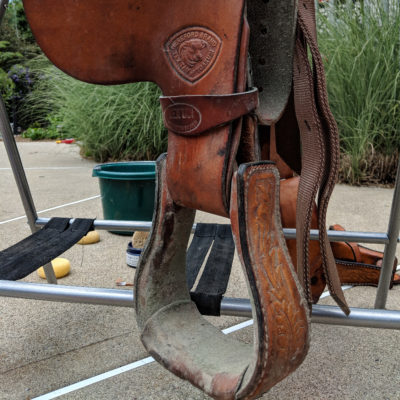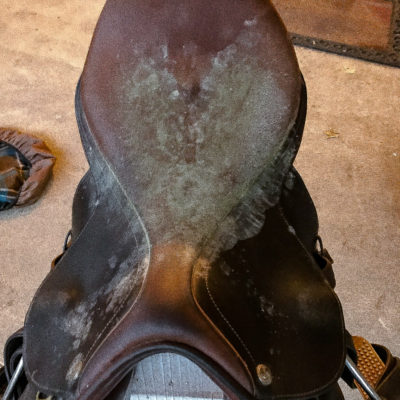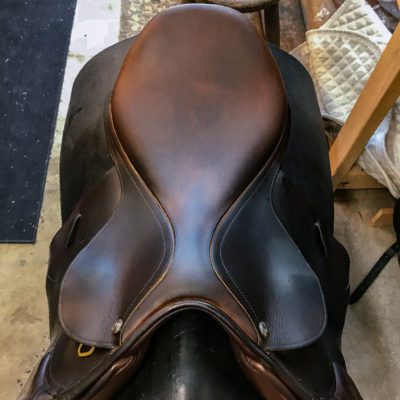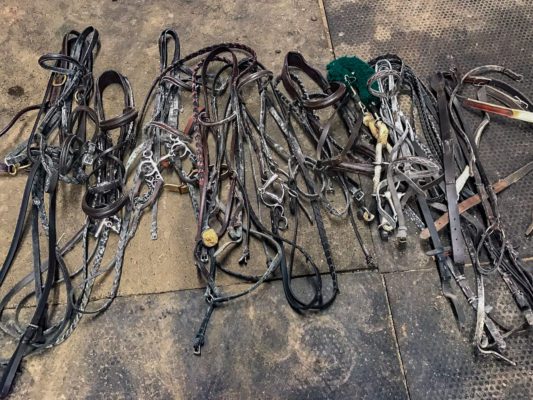How To Clean Mold Off A Saddle
How to Clean Moldy Leather
It's been a soggy few months here on the east coast. With all the rain and humidity in the air, it's nearly impossible to keep mold from growing in our tack rooms and all over our expensive saddles, bridles, and halters. Mold can be a nightmare to clean, but it must be done! Within a short time, mold can cause permanent damage to leather goods.
Moldy Leather: Cleaning, Storage, and Prevention
Mold and mildew are enemies of leather. They can easily invade not only your equipment, but also your tack rooms and other storage areas, causing expensive damage or ruining your tack entirely. Diligent maintenance and preventative care is much easier than replacing your equipment. If your area has a warm, humid climate you must take special care and clean your leather more frequently to prevent mold and mildew from growing on your tack.
What is Mold?
Mold and mildew are members of the fungi family. Other, more friendly, members of the fungi family are mushrooms and yeast. Fungi spores lay dormant in soil or other surfaces until conditions are right for "fruiting". Fruiting is when the fungi becomes noticeable to the human eye through blooming, which spread millions of spores. Fungi function to decompose organic matter in many different climates and environments—which is why they're so dangerous for your leather tack.
What Happens to Leather When Mold Begins to Grow?
If left alone, mold spores can become embedded in the matrix of your leather, making it brittle and weak. Mold, once it appears, may also get into the interior of your saddle where it cannot be cleaned or removed. Once mold is discovered, you must take immediate action to prevent further damage. Even then, it will likely continue to appear.
How to Prevent Mold from Growing on Your Leather
Storage
Mold spores thrive in warm, dark, damp places. Humidity levels between 65 and 85 percent provide the perfect environment for mold growth. Your tack room (or wherever your equipment is stored) should be kept well-lit, dry and ventilated. If you live in a humid climate, a dehumidifier or desiccant will help draw unwanted moisture out of the air. Make sure your storage area is as free from dust and dirt as can be managed. Even if you've been careful to clean mold from your leather equipment, if there's mold in your tack room it will continue to reappear.
Cleaning
Dirt, and other organic matter left on leather is the food that fuels mold growth. Sweat-soaked leather will break down, leaving it vulnerable. Moisture from sweat will also attract mold spores. The best maintenance to prevent the growth of mold and mildew is to wipe sweat and dirt off your equipment after every ride. Clean your equipment often but not harshly. Light but thorough cleanings are best!
Read more about regular maintenance cleaning and care for your leather tack.
How Can I Tell if My Tack Has Mold or Mildew?
Mold and mildew will most likely appear as a white or green dust on the surface of your leather, accompanied by a distinct odor.

How to Clean Moldy or Mildewed Leather
Always clean moldy equipment outdoors to prevent releasing spores back in the air in a confined space such as a tack room or barn. This will also help you avoid inhaling mold spores, especially if you're cleaning a piece of equipment heavily encrusted with mold, like the Western saddle above.
What You'll Need
Gather several sponges or old rags. Whatever you use to clean with, use it once and then throw it away. Rinsing is not enough to remove the spores from the sponges or rags and will only transfer the mold to other areas. Grab an old toothbrush to clean the stitching and get into hard-to-reach crevices.
You'll also need a pH-balanced soap to remove mold spores, dirt, and other organic matter that can serve as a food source for further mold growth. DO NOT USE vinegar, bleach, or alcohol—these will kill mold and prevent it from coming back, but damage your leather in the process. Any dilution of vinegar, bleach, or alcohol that is mild enough to use on your leather will not be strong enough to remove the mold.
Don't use glycerin soap, either. Glycerin soap is a "humectant," meaning it draws moisture to whatever surface it's used on. This is great for keeping your leather supple during regular maintenance, but in this case the moisture will only encourage further mold growth. A pH-balanced product will lubricate the leather to keep it supple without drawing excess moisture.
Removing the Mold
-
- First, wipe away all visible mold with a clean, damp cloth or sponge. You may need more than one sponge or rag for this step!
- When all mold that you can see is wiped away, throw out any sponges or rags you used.
- Use a clean rag or sponge to clean the leather using the pH-balanced soap. Then, wipe away any lather with another clean sponge.
- Once the equipment is cleaned, dry it in the sun to allow the water to evaporate. The UV rays in sunlight will also help kill and disinfect any remaining mold spores. Don't leave your tack in the sun too long, however—direct sunlight can also bake damp leather!


Constant Vigilance!
Once mold appears the first time, chances are you'll see it again. After you've cleaned your leather, let it dry, and ensure your tack room is as dry, light, and ventilated as you can make it. Check your equipment often for signs of mold regrowth. With a little effort, you'll catch any further mold and mildew before it can cause permanent damage.


Kate Wilson is a Society of Master Saddlers UK Qualified Saddle Fitter (SMS QSF) who has worked independently as a saddler and saddle fitter for nearly 25 years. She travels to work with clients throughout the Northeast United States. She is committed to helping equestrians at all levels achieve the best fit for themselves and their horses.
How To Clean Mold Off A Saddle
Source: https://www.dutchessbridlesaddle.com/2018/11/08/mold-its-a-four-letter-word/
Posted by: smithsursee.blogspot.com

0 Response to "How To Clean Mold Off A Saddle"
Post a Comment